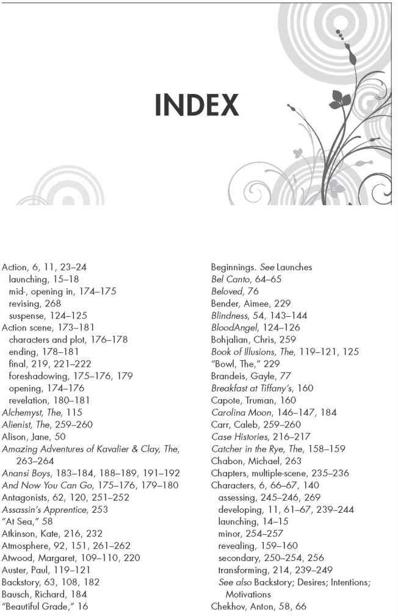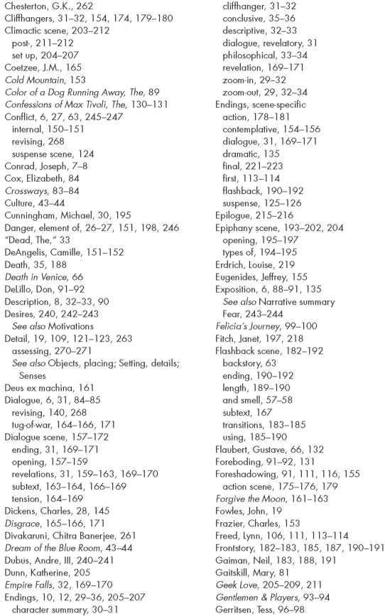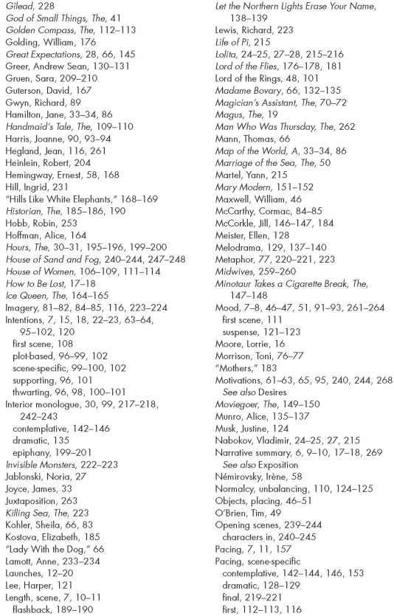Make A Scene (40 page)
Authors: Jordan Rosenfeld

It's important for you to be able to recognize when a scene is just a free-floating vignette that doesn't serve your narrative. There are multiple definitions for a vignette. My favorite is "a small, graceful literary sketch." To this let us add, "which does not necessarily relate to the plot, and is therefore extraneous." Vignettes may be some of the most beautiful passages in your entire narrative, but are vignettes—and not scenes—because they are conspicuously out of plot context, or missing an important scene element. In order to determine whether your scene is really a vignette, you must run it through another set of questions:
• Does the scene introduce new plot information?
• Does the scene relate to the significant situation?
• Does the scene build upon the last scene?
• Does the scene involve, inform, or affect the protagonist?
• Does the scene make the reader feel smarter or more clued in?
• Does the scene move forward in time (even if only by seconds)?
If the scene in question is relevant to your plot, the answer to every one of the above questions will be a resounding yes. If you answer no to
any
of those questions, you have a vignette, which needs to be fleshed out into a proper scene, or cut.
A vignette can be a half-formed scene, which is missing one of the core elements or lacks one of the necessary parts of its structure—a launch, middle, or end. But vignettes often get written because the author is taken with language or finds a character's inner life compelling. Among my editing clients, vignettes often show up as tangents; the writer stumbled onto an inspiring idea or a description, and ran with it. Unfortunately, vignettes usually please the writer far more than the reader.
Every scene is part of a larger matrix of scenes that add up to the outcome of your narrative. A vignette usually leaves the reader scratching his head, wondering why the scene was necessary. Ultimately, the most important question you can ask of a scene to determine whether it is a vignette, and thus whether it can be cut or transformed, is: Will my narrative still make sense and flow if I cut this scene out? If the answer is yes, you've got a vignette on your hands, and it doesn't belong.
TRANSFORMING OR CUTTING VIGNETTES
If you've determined that your scene is
not
relevant to your plot or character development, and thus is a vignette, then you have two options: Cut it, or make it relevant. If you decide to make it relevant, your next step is to determine what's missing so you can add it in. Here are some common missing elements when a scene feels too much like a vignette:
• Character motivation.
You have forgotten your character's motivations and relationship to the significant situation of your plot, and you have had him behave in an unrealistic or unrelated way.
Fix:
Go back to your character sketch (or do a new one) and see what more you can learn about your character that will fill in the blanks.
• Pertinent dialogue.
You've written a scene full of dialogue that goes nowhere, is too mundane, or does not pertain to plot.
Fix:
Edit or cut dialogue and look to the other methods described in this book for demonstrating character and revealing information.
• Setting.
You put your characters in a setting that does not make sense to your plot, or your setting is so vague that the reader doesn't understand how it relates.
Fix:
Ask yourself how important your setting is to your story. Determine if you have too much setting or not enough.
• Information.
Nothing new is revealed, so the momentum peters out.
Fix:
Think about what happens next and how can you reveal it.
•Action.
Your scene lacks enough action, and the reader finds it boring or gets distracted.
Fix:
Remember to think in forward motion. Ask what action could get your plot or characters moving in the most interesting way.
• Conflict.
There's not enough push-and-pull energy in the conflict, and the scene feels too easy to the reader, and, as a result, loses his attention.
Fix:
Consider the consequences. Refer back to your significant situation and make a list of all the consequences that have developed so far. Consider whether you have enough, and think about what additional ones you can drum up that will make sense to your plot.
When it comes time to cut a vignette, you're likely to suffer a moment of doubt, even panic. Always save your last draft of something before you revise, or save the excised pieces, so that you can reclaim them if you make a mistake and cut too soon. Generally, however, true vignettes will not be missed. In fact, you may feel a sense of clarity once they're gone, because all they did was obscure the plot.
If you feel empty or your plot stops making sense after you cut a scene, then most likely that was a valuable scene, and you should put it back in and try to fix what rings false about it.
PARING DOWN NARRATIVE SUMMARY
If you find that you have trouble assessing how much narrative summary to snip out, ask yourself these questions:
• If I cut the narrated section in question, will the plot or characters suffer? If no, then it can go.
• Can the narrative summary—family history, backstory, explanations— be revealed through dialogue, flashback, or action? If no, it can go.
• Have I repeated this information in another scene? If so, it can go.
The following are checklists for you to run through when it comes time to assess individual scenes that don't feel quite right to you.
ASSESSING SCENE ARCHITECTURE
One of the most important questions to ask when you're revising is whether your scenes are cohesive in structure, and if each one is not only a working individual unit, but also sets up the next scene. Does each scene:
• Have a beginning, a middle, and an end?
• Launch vividly and engage the reader?
• Have a rich subtext, with texture, themes, and imagery?
• Include complications that up the ante on the characters?
• Leave the reader hungry for more upon its ending?
• End in a logical way that leaves room for the next scene to launch?
ASSESSING CORE ELEMENTS
Because there are so many core elements in a scene, you'll really want to take a solid look at each scene to see if it fulfills the goals of setting and the senses, if characters are well-developed, and if it contains enough tension to keep the reader's interest.
Visual and Sensual Details
Does each scene:
• Have an effective setting that is vivid but not overbearing?
• Reveal the time, place, and culture of your setting?
• Use objects to reveal details about plot and character?
• Engage the senses to create a sense of realism and authenticity? (Don't forget those seemingly mundane senses, like taste and hearing.)
Characters
Does each scene:
• Include a distinctive protagonist within the first two paragraphs?
• Feature useful minor characters as catalysts and antagonists?
• Use voice, dialogue, and behavior, rather than narrative summary, to reveal character?
• Keep consistent points of view?
• Offer your protagonist a chance to act or react?
• Force your protagonist to reevaluate or change?
• Engage your protagonist in the plot?
Plot
Does each scene:
• I ntroduce at least one new piece of information (who, what, where, when, how, or why)?
• Build upon the information revealed in the last scenes?
• Relate only information that ties directly to the significant situation and its consequences?
• Dole out plot information slowly, creating a sense of mystery?
• Use flashback scenes in place of backstory where needed?
Dramatic Tension
Does each scene:
• Employ subtlety over melodrama?
• Create an emotional response in the reader, not just the characters?
• Create the feeling of potential conflict?
•Thwart your protagonist's goals, delaying satisfaction?
•Throw in unexpected changes without immediate explanation?
• Shift power back and forth?
• Pull the rug out—throw in a piece of plot information that changes or alters your protagonist in some way?
• Create a tense atmosphere through setting and senses?
ASSESSING SCENE TYPES
At the end of each scene type chapter you will find a bulleted list of muse points. Refer to these when assessing a specific scene type.

All in all, any "no" answers to the questions on these lists gives you an instant indication of where your scene needs to be strengthened.
When you assess individual scenes, you create a cohesive sense of integrity in your overall narrative, because you assess each scene not only on its own merits, but on its contribution to the adjacent scenes and to the storyline as a whole.



